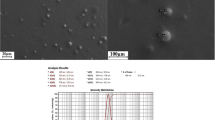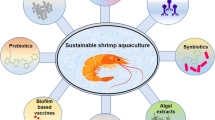Abstract
Alternative prophylactic strategies to limit farm animal infection are needed in order to avoid the use of antibiotics. Anti-bacterial and immunostimulatory properties of bioactive compounds are of great interest in aquaculture. Marine derived polysaccharides, such as chitosan and ulvan, together with nanotechnology, have become the focus of attention in the scientific community due to their wide range of biological properties. In this work, chitosan and ulvan-loaded chitosan nanoparticles (referred as CS-TPP NPs and CS-UL-TPP NPs, respectively), obtained by the ionotropic gelation method, had round shape, and the mean sizes were 137.00 ± 5.44 and 325.50 ± 4.95 nm, respectively. No study about the anti-bacterial activity of both types of NPs against Photobacterium damselae subsp. piscicida, an important fish pathogen, has been reported so far. Furthermore, the potential immunostimulatory effects of CS-UL-TPP NPs after oral administration in fish have not yet been evaluated. The percentage of bacterial inhibition against P. damselae subsp. piscicida was determined through in vitro assays, and it was significantly higher in CS-UL-TPP NPs than in CS-TPP NPs at concentrations below 0.03 mg mL−1. The effects on the immune system of CS-TPP and CS-UL-TPP NPs were evaluated in Solea senegalensis juveniles at 30 days after oral administration. Lysozyme activity as well as gene expression levels of il1b, il6, hamp1, tf and c3 was significantly higher in CS-UL-TPP NP-treated groups than in the controls, and no significant differences were observed in CS-TPP NP-treated groups. Thus, ulvan extracted from the macroalgae Ulva ohnoi could improve anti-bacterial and immunostimulant properties of CS-TPP NPs thereby making them suitable to be used as vaccine adjuvant or as immunostimulant.




Similar content being viewed by others
Data Availability
The authors confirm that the data supporting the findings of this study are available within the article.
References
Abdel-Razek N (2019) Antimicrobial activities of chitosan nanoparticles against pathogenic microorganisms in Nile tilapia, Oreochromis niloticus. Aquacult Int 27:1315–1330
Ahmed F, Soliman FM, Adly MA et al (2019) Recent progress in biomedical applications of chitosan and its nanocomposites in aquaculture: a review. Res Vet Sci 126:68–82
Ahmed F, Soliman FM, Adly MA et al (2021) Dietary chitosan nanoparticles: potential role in modulation of rainbow trout (Oncorhynchus mykiss) antibacterial defense and intestinal immunity against enteric redmouth disease. Mar Drugs 19:72
Akbary P, Aminikhoei Z (2018) Effect of water-soluble polysaccharide extract from the green alga Ulva rigida on growth performance, antioxidant enzyme activity, and immune stimulation of grey mullet Mugil cephalus. J Appl Phycol 30:1345–1353
Cañavate JP, Anguís-Climent V, Fernández-Díaz C (2021) Efficient use of bicarbonate for mass production and carbon isotopic labelling of the green alga Ulva ohnoi under natural conditions. J Appl Phycol 33:3987–3999
Carballo C, Chronopoulou EG, Letsiou S, Maya C, Labrou NE, Infante C, Power DM, Manchado M (2018) Antioxidant capacity and immunomodulatory effects of a chrysolaminarin-enriched extract in Senegalese sole. Fish Shellfish Immunol 82:1–8
Chandrasekaran M, Kim KD, Chun SC (2020) Antibacterial activity of chitosan nanoparticles: a review. Processes 8:1173
Cox S, Abu-Ghannam N, Gupta S (2010) An assessment of the antioxidant and antimicrobial activity of six species of edible Irish seaweeds. Int Food Res J 17:205–220
Dawood MAO, Gewaily MS, Soliman AA et al (2020) Marine-derived chitosan nanoparticles improved the intestinal histo-morphometrical features in association with the health and immune response of grey mullet (Liza ramada). Mar Drugs 18:611
Dawood MAO, Koshio S, Esteban MÁ (2018) Beneficial roles of feed additives as immunostimulants in aquaculture: a review. Rev Aquac 10:950–974
Divya K, Vijayan S, George TK, Jisha MS (2017) Antimicrobial properties of chitosan nanoparticles: mode of action and factors affecting activity. Fibers and Polymers 18:221–230
Dodgson KS (1961) Determination of inorganic sulphate in studies on the enzymic and non-enzymic hydrolysis of carbohydrate and other sulphate esters. Biochemical Journal 78:312–319
Fernández-Díaz C, Coste O, Malta EJ (2017) Polymer chitosan nanoparticles functionalized with Ulva ohnoi extracts boost in vitro ulvan immunostimulant effect in Solea senegalensis macrophages. Algal Res 26:135–142
Ghadi A, Mahjoub S, Tabandeh F, Talebnia F (2014) Synthesis and optimization of chitosan nanoparticles: potential applications in nanomedicine and biomedical engineering. Caspian J Intern Med 5:156–161
Harikrishnan R, Devi G, van Doan H et al (2021) Efficacy of ulvan on immune response and immuno-antioxidant gene modulation in Labeo rohita against columnaris disease. Fish Shellfish Immunol 117:262–273
Ibrahim MIA, Amer MS, Ibrahim HAH, Zaghloul EH (2022) Considerable production of ulvan from Ulva lactuca with special emphasis on its antimicrobial and anti-fouling properties. Appl Biochem Biotechnol 194:3097–3118
Infante C, Matsuoka MP, Asensio E et al (2008) Selection of housekeeping genes for gene expression studies in larvae from flatfish using real-time PCR. BMC Mol Biol 9:28
Jiménez-Fernández E, Ponce M, Rodríguez-Rúa A, Manchado M, Fernández-Díaz C (2018) Assessing the role of vitamin C and iron in early larvae stages of Solea senegalensis fed enriched Artemia. Aquaculture 488:145–154
Kidgell JT, Magnusson M, de Nys R, Glasson CRK (2019) Ulvan: a systematic review of extraction, composition and function. Algal Res 39:101422
Livak KJ, Schmittgen TD (2001) Analysis of relative gene expression data using real-time quantitative PCR and the 2-ΔΔCT method. Methods 25:402–408
Lulijwa R, Rupia EJ, Alfaro AC (2020) Antibiotic use in aquaculture, policies and regulation, health and environmental risks: a review of the top 15 major producers. Rev Aquac 12:640–663
Magnadóttir B (2006) Innate immunity of fish (overview). Fish Shellfish Immunol 20:137–151
Mohan K, Ravichandran S, Muralisankar T et al (2019) Application of marine-derived polysaccharides as immunostimulants in aquaculture: a review of current knowledge and further perspectives. Fish Shellfish Immunol 86:1177–1193
Morais S, Aragão C, Cabrita E et al (2016) New developments and biological insights insights into the farming of Solea senegalensis reinforcing its aquaculture potential. Rev Aquac 8:227–263
Ngan LTK, Wang SL, Hiep IM et al (2014) Preparation of chitosan nanoparticles by spray drying, and their antibacterial activity. Res Chem Intermed 2165–2175
Nguyen TV, Nguyen TTH, Wang SL et al (2017) Preparation of chitosan nanoparticles by TPP ionic gelation combined with spray drying, and the antibacterial activity of chitosan nanoparticles and a chitosan nanoparticle–amoxicillin complex. Res Chem Intermed 43:3527–3537
Perinelli DR, Fagioli L, Campana R et al (2018) Chitosan-based nanosystems and their exploited antimicrobial activity. Eur J Pharm Sci 117:8–20
Ponce M, Zuasti E, Anguís V, Fernández-Díaz C (2020) Effects of the sulfated polysaccharide ulvan from Ulva ohnoi on the modulation of the immune response in Senegalese sole (Solea senegalensis). Fish Shellfish Immunol 100:27–40
Ponce M, Salas-Leiton E, Garcia-Cegarra A, Boglino A, Coste O, Infante C, Gisbert E, Rebordinos L, Manchado M (2011) Genomic characterization, phylogeny and gene regulation of g-type lysozyme in sole (Solea senegalensis). Fish Shellfish Immunol 31(6):925–37
Ponce M, Zuasti E, Reales E et al (2021) Evaluation of an oral DNA nanovaccine against photobacteriosis in Solea senegalensis. Fish Shellfish Immunol 117:157–168
Salas-Leiton E, Anguis V, Martin-Antonio B, Crespo D, Planas JV, Infante C, Canavate JP, Manchado M (2010) Effects of stocking density and feed ration on growth and gene expression in the Senegalese sole (Solea senegalensis): potential effects on the immune response. Fish Shellfish Immunol 28(2):296–302
Santos L, Ramos F (2018) Antimicrobial resistance in aquaculture: current knowledge and alternatives to tackle the problem. Int J Antimicrob Agents 52:135–143
Sarkar B, Mahanty A, Gupta SK et al (2022) Nanotechnology: a next-generation tool for sustainable aquaculture. Aquaculture 546:737330
Saurabh S, Sahoo PK (2008) Lysozyme: an important defence molecule of fish innate immune system. Aquac Res 39:223–239
Sørum H (2008) Antibiotic resistance associated with veterinary drug use in fish farms. Improving Farmed Fish Quality and Safety 157–182
Sulastri E, Zubair MS, Lesmana R et al (2021) Development and characterization of ulvan polysaccharides-based hydrogel films for potential wound dressing applications. Drug Des Dev Ther 15:4213–4226
Torrealba D, More-Bayona JA, Wakaruk J, Barreda DR (2019) Innate immunity provides biomarkers of health for teleosts exposed to nanoparticles. Front Immunol 10:3074
van Tran TT, Truong HB, Tran NHV et al (2018) Structure, conformation in aqueous solution and antimicrobial activity of ulvan extracted from green seaweed Ulva reticulata. Nat Prod Res 32:2291–2296
Valderrama K, Balado M, Rey-Varela D et al (2019) Outer membrane protein FrpA, the siderophore piscibactin receptor of Photobacterium damselae subsp. piscicida, as a subunit vaccine against photobacteriosis in sole (Solea senegalensis). Fish Shellfish Immunol 94:723–729
Wang L, Hu C, Shao L (2017) The antimicrobial activity of nanoparticles: present situation and prospects for the future. Int J Nanomed 12:1227–1249
Wu Y, Rashidpour A, Almajano MP, Metón I (2020) Chitosan-Based drug delivery system: Applications in fish biotechnology. Polymers (basel) 12:1177
Younus N, Zuberi A, Mahmoood T et al (2020) Comparative effects of dietary micro- and nano-scale chitosan on the growth performance, non-specific immunity, and resistance of silver carp Hypophthalmichthys molitrix against Staphylococcus aureus infection. Aquacult Int 28:2363–2378
Zhao Y, Yang QE, Zhou X et al (2021) Antibiotic resistome in the livestock and aquaculture industries: status and solutions. Crit Rev Environ Sci Technol 51:2159–2196
Acknowledgements
The authors are grateful to Carmen Balebona (Universidad de Malaga) for donating the strain P. damselae subsp. piscicida Lg41/01 and to Cupimar S.A. for supplying Senegalese sole juveniles. The authors thank Isabel Ponce for the proofreading of the manuscript.
Funding
This work was supported by the project PP.FEM.PPA201700.9 co-financed at 75% by the European Maritime and Fisheries Fund within the Operational Programme for Spain 2014–2020.
Author information
Authors and Affiliations
Contributions
Marian Ponce: conceptualization, methodology, investigation, formal analysis, writing — original draft, and writing — review and editing. Eugenia Zuasti: methodology and investigation. Victoria Anguís: methodology, investigation, and resources. Catalina Fernández Díaz: conceptualization, methodology, writing — review and editing, supervision, and funding acquisition.
Corresponding author
Ethics declarations
Conflict of Interest
Authors declare that they have not conflict of interest.
Additional information
Publisher's Note
Springer Nature remains neutral with regard to jurisdictional claims in published maps and institutional affiliations.
Highlights
• CS-TPP and CS-UL-TPP NPs have anti-bacterial activity against P. damselae subsp. piscicida.
• CS-UL-TPP NPs leads to the triggering of the immune response in Solea senegalensis.
• Ulvan could boost both, anti-bacterial and immunostimulant properties of CS-TPP NPs.
Rights and permissions
Springer Nature or its licensor (e.g. a society or other partner) holds exclusive rights to this article under a publishing agreement with the author(s) or other rightsholder(s); author self-archiving of the accepted manuscript version of this article is solely governed by the terms of such publishing agreement and applicable law.
About this article
Cite this article
Ponce, M., Zuasti, E., Anguís, V. et al. Anti-Bacterial and Immunostimulatory Properties of Ulvan-Loaded Chitosan Nanoparticles for Use in Aquaculture. Mar Biotechnol 26, 19–27 (2024). https://doi.org/10.1007/s10126-023-10272-x
Received:
Accepted:
Published:
Issue Date:
DOI: https://doi.org/10.1007/s10126-023-10272-x




